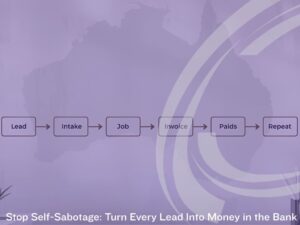What Most Business Owners Miss When Reviewing Their Performance

Most small business owners review their performance at least semi-regularly. They glance at the numbers, check their bank account, or ask how the team is doing. But despite best intentions, many are missing the signals that truly matter.
In this article, we break down what most business owners miss when reviewing their performance, and how Australian SMEs can shift from superficial checks to strategic review habits that build resilience and unlock growth.
Data is abundant. Insight is rare. The difference lies in what you’re looking for, and what you’re not.
Why Reviewing Performance Is a Non-Negotiable
No business can thrive without measurement. But measurement without insight becomes noise.
When done well, a performance review should:
- Validate what’s working
- Flag what’s slipping
- Guide priorities for the next period
- Inform decision-making
- Strengthen accountability and clarity
However, understanding what most business owners miss when reviewing their performance begins with recognising that many reviews are rushed, overly financial, or too narrow in focus.
The Three Common Traps in Business Performance Reviews
- Focusing Only on Financials
It’s easy to obsess over the profit and loss statement or your bank balance. But financials are lagging indicators. They tell you what’s already happened.
If you’re not reviewing leading indicators, like lead generation, project pipeline, or team capacity, you’re flying blind.
- Reviewing Without Reflecting
A performance review isn’t just a report; it’s a conversation. What patterns do the numbers reveal? What context influenced the results?
If your review ends when the spreadsheet closes, you’ve missed the opportunity for insight.
- Missing the ‘Why’ Behind the ‘What’
Many business owners see that revenue is down, but don’t dig into what caused it. They see client churn, but not the process gaps behind it. Data without diagnosis leads to reactive behaviour.
These blind spots are central to what most business owners miss when reviewing their performance.
What Should Be Included in a Business Performance Review?
A truly strategic review goes beyond the numbers. It encompasses multiple dimensions that reflect your business’s health, capability, and direction. Here are six key areas:
- Financial Health
- Profit and loss trends
- Gross margin and overheads
- Aged receivables and payables
- Cash flow forecast
- Budget vs actuals
This is foundational, but not final.
- Customer Value
- Customer satisfaction scores
- Repeat business rates
- Referral and review trends
- Time-to-service or delivery
What most business owners miss when reviewing their performance is that revenue doesn’t always indicate value. A client may be profitable on paper but draining operational resources.
- Team Performance
- Capacity tracking
- Project delivery times
- Leave utilisation
- Productivity blockers
Without structured feedback loops, you’re missing how your people are really performing and feeling.
- Marketing Effectiveness
- Lead generation volume and quality
- Conversion rates by source
- Cost per acquisition
- Website or social media engagement
Many businesses invest in marketing but don’t track if it’s delivering—not just eyeballs, but buyers.
- Operational Efficiency
- Job or project cycle times
- Rework or complaint rates
- Admin time per function
- System usage and tool value
This area is often neglected but has the most immediate ROI when improved.
- Strategic Alignment
- Goal progress
- Strategic project completion
- Quarterly theme delivery
- Opportunity tracking
If your reviews only measure output, not alignment to strategy, you’re managing activity—not performance.
Understanding Patterns, Not Just Points
Most business owners view performance data as a snapshot. The smarter ones read it like a movie.
Trends matter more than totals. If revenue is up but profitability is flat, what’s changing? If staff hours are steady but project delays increase, what’s causing the lag?
Patterns reveal process flaws, resource constraints, and strategic missteps. That’s what most business owners miss when reviewing their performance: the story the data is trying to tell.

Why Business Owners Miss These Signals
There are several reasons Australian SMEs, in particular, overlook key performance signals:
- Time Pressure
Most owners are operationally overloaded. Reviews get pushed to the end of the month—or skipped altogether.
- Lack of Framework
Without a structured template, reviews become guesswork. Owners don’t know what to look for beyond the obvious.
- Data Disconnection
If systems aren’t integrated, data lives in silos. Financials sit in Xero, leads in the CRM, and customer issues in emails.
- Avoidance
Sometimes, reviewing performance shines a light on things we’d rather not face: underperformance, debt, or stalled progress.
- Misconceptions
Many believe that only large businesses need structured review rhythms. In fact, the smaller your business, the more critical performance clarity becomes.
Building a Better Performance Review Rhythm
Understanding what most business owners miss when reviewing their performance leads to one conclusion: rhythm matters.
You don’t need a full-day off-site to review performance. You need a consistent structure that fits your business cycle.
Suggested Monthly Review Flow:
- Week 1: Data gathering and dashboard updates
- Week 2: Strategic coaching or internal review session
- Week 3: Team reflection and planning
- Week 4: Adjustment of goals and resources
Even a 90-minute session with good inputs can transform how you lead and plan.
Reviewing Performance in Context: The Australian SME Landscape
Small businesses in Australia operate in a uniquely challenging context:
- Thin margins in many industries
- Complex compliance obligations
- A geographically dispersed customer base
- Fluctuating access to skilled staff
- Sector-specific market volatility
Because of this, performance reviews must consider external pressures as well as internal activity. A flat quarter may be a success in a declining market. A spike in staff turnover may reflect national trends.
Contextual analysis is a critical component of what most business owners miss when reviewing their performance.
Using Coaching to Strengthen Review Quality
At SBAAS, we use monthly coaching sessions not just to discuss goals, but to dissect data. Every Actually Supported client has access to a structured review format that goes far beyond standard reports.
We review:
- Financial performance against forecast
- Operational efficiency across departments
- People performance with a lens on culture
- Marketing effectiveness by campaign and platform
- Strategic goal alignment and delivery
We don’t just ask “how are things?”, we ask “what’s shifting, and what needs attention?”
This review rhythm transforms performance management from a chore into a competitive advantage.
Tools That Support Better Reviews
Even without a complete ERP or analytics team, small businesses can implement review structures using accessible tools:
- Xero or QuickBooks for financial snapshots
- Google Looker Studio for marketing dashboards
- Trello, Asana, or ClickUp for project tracking
- CRM tools like Zoho or HubSpot for sales metrics
- SBAAS coaching dashboards for integrated insights
The key is consistency. A simple system used regularly beats a complex one used sporadically.
The Cost of Getting It Wrong
Ignoring the deeper insights of performance reviews leads to:
- Missed revenue opportunities
- Burnt-out staff
- Inefficient processes
- Poor forecasting
- Strategy that never gets implemented
Perhaps most critically, it leads to a dangerous illusion that things are “fine”—until they’re not.
Avoiding these pitfalls is at the heart of what most business owners miss when reviewing their performance.
Data Doesn’t Lie, But It Also Doesn’t Speak
If you want better business outcomes, start by asking better questions. Performance reviews aren’t about looking smart; they’re about getting smarter.
They require structure, curiosity, and a willingness to dig beneath the surface. They also require rhythm, because a once-a-year reflection won’t reveal the patterns you need to see.
You don’t need to become a data analyst. You need to become an insight-driven leader.
Ready to Review Smarter, Not Harder?
At SBAAS, we help business owners stop reacting and start reviewing with confidence. Our Actually Supported coaching program integrates monthly performance reviews, strategic insights, and operational accountability, so nothing gets missed and progress moves forward.
Book a conversation today or learn more about SBAAS to find out how we help businesses like yours uncover what really matters and act on it.

Eric Allgood is the Managing Director of SBAAS and brings over two decades of experience in corporate guidance, with a focus on governance and risk, crisis management, industrial relations, and sustainability.
He founded SBAAS in 2019 to extend his corporate strategies to small businesses, quickly becoming a vital support. His background in IR, governance and risk management, combined with his crisis management skills, has enabled businesses to navigate challenges effectively.
Eric’s commitment to sustainability shapes his approach to fostering inclusive and ethical practices within organisations. His strategic acumen and dedication to sustainable growth have positioned SBAAS as a leader in supporting small businesses through integrity and resilience.
Qualifications:
- Master of Business Law
- MBA (USA)
- Graduate Certificate of Business Administration
- Graduate Certificate of Training and Development
- Diploma of Psychology (University of Warwickshire)
- Bachelor of Applied Management
Memberships:
- Small Business Association of Australia –
International Think Tank Member and Sponsor - Australian Institute of Company Directors – MAICD
- Institute of Community Directors Australia – ICDA
- Australian Human Resource Institute – CAHRI
Our Consulting Services

Management Consulting
Compliance & Risk

Professional Writing Services
Consistency in Communication

Small Business Consulting
Sustainable Businesses

Start-ups
Set-up for Success
Further reading

Pragmatism Wins: How Australian Businesses Turn AI Hype Into Real Results
Australian organisations are moving beyond experiments. This article shows how Australian businesses across all sectors and sizes can scale value, manage risk, and boost productivity with pragmatic AI.

Stop Self-Sabotage: Turn Every Lead Into Money in the Bank
Winning work is hard. Losing time and cash to clunky admin is optional. This guide shows how to design an automated business process that captures leads, books jobs, issues invoices with timely reminders, and keeps clients returning. Plain English, practical steps, and a sharp focus on simplification, speed, and cash flow.

Seeing the Wrong Picture: What Most Business Owners Miss When Reviewing Their Performance
Business owners aren’t short on data, but many are missing what matters most. Discover what most business owners miss when reviewing their performance and how to shift from surface-level tracking to strategic insight.

Navigating Economic Uncertainty: A Roadmap for Australian Small Businesses
Discover how global economic shifts and local consumer sentiment are reshaping Australian small businesses. Equip yourself with actionable insights and strategies to thrive amidst uncertainty.

The Hidden Cost of Success: How Leadership Burnout is Crippling Australia’s Small Business Sector
Leadership burnout is rising fast across Australia’s small business sector. This article unpacks what it looks like, what causes it, and how SME leaders can protect themselves and their teams before the damage becomes irreversible.

From Centre to the Edges: A Practical Guide to the Political Left to Right Scale for Australian Business
We hear “far left” and “far right” every day. This guide starts in the middle, explains each step to the edges, and shows what the political left-to-right scale means for Australian enterprises of all sizes.
SBAAS Events
What our clients are saying about us
Posted onTrustindex verifies that the original source of the review is Google. Eric and Trudi recently wrote a tender for me and the experience was amazing. I went into the process in a state of complete overwhelm. Eric was able to break it down into achievable chunks for me, and reassure me that I had a great service and business model to offer. I came out the other end of the process with all of my business policies, a better understanding of my offer, and a foundation to launch all future tender applications. Eric took all of my information and turned it into a pretty package that I could market.Posted onTrustindex verifies that the original source of the review is Google. SBAAS were fantastic to work with on a detail-heavy tender with a tight turnaround. Their team helped us shape and compile our content to deliver a strong, high-quality submission. Highly recommend SBAAS to anyone looking for strategic support with tender development, with a touch of good humour along the way.Posted onTrustindex verifies that the original source of the review is Google. We engaged SBAAS to support the development of a complex government tender and couldn’t be happier with the outcome. SBAAS' professionalism, attention to detail, and ability to quickly understand our business and translate that into a compelling, well-structured submission were exceptional. They were responsive, collaborative, and a genuine extension of our team. Highly recommend for anyone looking for strategic, high-quality bid and tender writing support.Posted onTrustindex verifies that the original source of the review is Google. Eric and Team go above and beyond. They do an excellent job with researching to get everything that is legally required for Policies and QMS. Would recommend them them to everyone especially all the bookkeepers and accountants. Thank you guys, and extreme job. Love you work as always. 😀Posted onTrustindex verifies that the original source of the review is Google. Extremely professional and far exceeded by expectations. I will definitely be using their services again and highly recommend them. They have a spirit of excellence in everything they do which shines through when dealing with them.Posted onTrustindex verifies that the original source of the review is Google. Impressive consulting experience! The team is highly professional, with a hands-on approach that adds real value. Their dedication and expertise truly stand out. Highly recommended!Posted onTrustindex verifies that the original source of the review is Google. Super knowledgable company that provides great advice and support for small business. Super friendly, highly recommend.Posted onTrustindex verifies that the original source of the review is Google. As a new business owner, I recognised the value in seeking a business coach to help me achieve significant goals. After a disappointing experience with a previous coach, I was initially hesitant to try again. However, after seeing SBAAS's complimentary action plan, I thought there was no harm in investigating. Eric quickly identified gaps in my systems, and through a few targeted adjustments, I saw an immediate increase in both leads and sales. These changes also improved profitability—highlighting a major issue I hadn’t been aware of, as my previous coach’s guidance had me working for less than $7 per hour! I look forward to continuing working with Eric.
